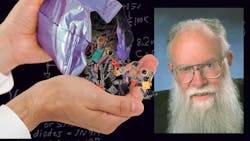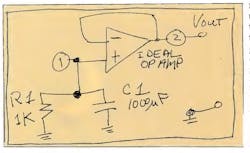This article is part of Bob Pease's Floobydust series found in the Electronic History section of our Series Library.
First of all, I should explain that "Floobydust" is an old term that was invented here at National, a phrase coined by Dennis Bohn, meaning "miscellaneous" or "potpourri" - a "Mixed bag." A catch-all phrase. And that's what we have this month. For example:
- Several people have asked, "Why do we now have a Pease Porridge column only every other issue?" Well, I LIKE to write a column every issue, twice a month. But after putting out more than 40 columns, I am finding that all of the easy ones have been written. The ones I am writing now take more research, more breadboarding, more special permissions and approvals, more time, more work. I'd rather write just one column per month and get it right. Meanwhile, because there are so many excellent letters from readers, I'd feel bad if we couldn't get a lot of them printed. Running a good batch of letters once a month helps keep me from burning out on writing columns on tough subjects. And I hope you are enjoying the letters, too.
- Also, I just learned recently that my column is being translated and published in the Russian-language version of Electronics. A knowledgeable friend assured me that the translation is quite good, retaining much of the style of the original. So if anybody is studying the Russian language and would like a few copies, hit me with a 52-cent SASE and I'll send you some good columns in Russian.
- Recently, I got a letter from Michael Ellis, Research Engineer, at the U.S. Army Corps of Engineers, Vicksburg, Miss.:
"Dear Mr. Pease, I have enjoyed your commentaries on Spice, and your own articles have enticed me to personally explore Spice. Since Spice obviously solves for circuit voltages using numerical techniques, I presented a circuit to Spice for simulation. This particular circuit represents the simplest case of a mathematical class of differential equations known as 'stiff' equations. he significance is that there is no known stable solution to 'stiff' equations using numerical techniques (see the figure).
The 1000-µF capacitor C1 is assumed to have a 1-V dc charge as an initial condition; then it is discharged by the 1-k resistor. Spice is asked to simulate the voltages V1 and V2 over time. My Spice file is:
R1 1 0 1K C1 1 0 1000UF IC=1V EAMP 2 0 1 2 10E5 .PRINT TRAN V(1) V(2) .TRAN 1S 100S UIC .END
The Spice solution is compared with the exact solution V = e-t/RC at a few points (see the table). The solution continues to degrade and the percent error will increase to well beyond 1000% as time goes on. One might ask why such small voltages are significant. However, in many areas, including radio astronomy, a signal of nanovolts in a very narrow bandwidth might be of utmost importance. This particular Spice simulation uses an ideal op amp and still gives the wrong answer (the op amp works fine since V(2) tracks V(1) exactly). At time=20 seconds, the voltage V(1) is negative, which in reality is impossible for any real or theoretical circuit with an initial condition of +1.0 V dc on the capacitor. It would also be impossible for any manufacturer to guarantee the Spice model of his op amp in such a case because the errors are entirely due to the passive components."
Obviously I found this letter intriguing, especially as I am such an expert with Spice. (That's supposed to be a joke.) I set up the circuit in Spice, and in a couple minutes I got a solution. I fooled around some more and got several other solutions. After some thought, I constructed this answer.
No, you can't just blame the errors on the passive components. It is a set of computational errors, and like any other computer problem, you should ask the computer a question for which you know the answer, exactly as Mr. Ellis has done. THEN if you don't like the answer, you trick the computer into giving an answer you like.
In this case, I merely guessed that if I broke the question down into smaller elements, I could get finer computations. On my initial computations, I got an error of just -20% at t = 20 seconds - rather less error than the -137% Mr. Ellis did. So on my next run, I asked for . TRAN 0 . 1S 20S UIC, namely, I asked the computer to compute the answer for each 0.1-second interval. (I decided to truncate the problem at t=20 seconds, because when the output is smaller than 0.001 ppm of the input conditions, I really don't care any more. Even radar sets that transmit in kilovolts and then receive in microvolts don't need much more dynamic range than that....) The computation time then stretched out from 0.25 seconds on our mainframe to 1.2 seconds, a mere factor of 5 extension. And the accuracy at t=20 seconds improved to 2%.
Hey, that's pretty good engineering accuracy. That's reminiscent of the scientist and the engineer who were both put into a room with a beautiful woman. They were told that each second, they would move 1/2 the distance to the woman. The scientist moaned, "I'll never get there." But the engineer just smiled. "I'll get close enough."
I also bounced this Spice question off Dave Hindi, a real Spice expert. He countered that when you really want tighter relative accuracy, you should ask for a tighter RELative TOLerance of the computations:
OPTIONS RELTOL=1E-08
which is much tighter than the normal (default value) of 0.001. Indeed, this did tighten up the computations. But Dave was running his computations on a small, powerful PC, and asking for such a small RELTOL did cause the computation to slow down. And, his answers were not all as precise as mine. Still, this indicates there are two ways to sweet-talk the computer into giving very good computational accuracy.
- In my 1991 column on Negative Feedback, I observed that according to an old story George Philbrick told me, somebody invented a clock-adjuster back in the 1500s or 1600s - a big old slow phase-locked loop. So far, we have not found any documented example that goes back that far, but I did get a letter from Owen Gallagher, Stratus Computer, Marlboro, Mass. He sent me an excerpt from a book about The Origins of Feedback Control, translated from the German version (1969) and published by the MIT Press, Cambridge, Mass., in 1970.
First you should note that the flyball governor was probably invented by Matthew Boulton about 1788, and constructed in James Watt's workshop about 1789.
In chapter XI of this book, credit is given to Abraham-Louis Breguet, a skilled French-Swiss watchmaker living in Paris, for inventing a watch-synchronizer, along nearly the same lines as I recited in George Philbrick's old story. This invention was documented by a letter dated June 29, 1795 - just a few years after the centrifugal governor attributed to Watt. So, even though the story I gave you was off by a century or two, the basic concept has been confirmed.
- Lastly, I'll comment about old cars. Several readers questioned me pointedly: Even if I can keep my old 1968 VW Beetle running reliably and economically (now at 260,000 miles), is it right to keep this old car running when it is "obviously" polluting the air much worse than modern cars?" A fair question....
I checked on some of the data on smog tests taken on my VWs in recent years. In California, these old cars do not have test limits on pollutants at running speeds, only at idle speeds. BUT the service stations took the 2500 rpm data anyhow:
Hydrocarbons: 102 ppm, 185, 188, 148 ppm.
Carbon monoxide: 1.14%, 1.15%, 0.36%, 0.64%.
The corresponding test limits that I have seen for modern cars are 220 ppm of hydrocarbons and 1.2% CO. My old car was passing these test limits without any special effort. Just because a car is old or "obsolete" doesn't mean it is necessarily smoggy or polluting. Besides, I am getting 29 mpg, and the percentages are based on a total exhaust volume that's obviously smaller than for larger cars that burn more gas and air.
Read What's All This Floobydust Stuff, Anyhow? (Part 2)
All for now./Comments invited! RAP/Robert A. Pease/Engineer
Address: Mail Stop C2500A, National Semiconductor, P.O. Box 58090, Santa Clara, CA 95052-8090
Bob's Mailbox
Dear Robert,
I have enjoyed your articles since they began, because I have been an analog circuit designer for about the last 30 years. Normally I am in full agreement with you, but your article on spreadsheets surprised me.
I have used spreadsheets for about the last 10 years and have found them to be very useful as an engineering instrument. Notice that I say instrument because they must be built very carefully, tested very extensively, and used with common sense and care in mind, just as we would use an oscilloscope or a voltmeter.
There are about a dozen fairly simple spreadsheets that I regularly use for engineering calculations and estimates. They work because they were very carefully designed and tested using many examples checked by old-fashioned methods and double-checked by several other people.
The spreadsheet is just another instrument/tool, maybe similar to Spice, which must be used with a lot of good engineering judgment and care. Regular calibration checks are needed and circuit modifications are made with the greatest care and patience, followed by rigorous testing.
Robert L. Young, DuPont, Parkersburg, W.V.
Like any other calibrated instrument, a calibrated spreadsheet is a lot more valuable than something uncalibrated, untested, and unconfirmed.-RAP
About the Author

Bob Pease
Bob obtained a BSEE from MIT in 1961 and was a staff scientist at National Semiconductor Corp., Santa Clara, CA, for many years. He was a well known and long time contributing editor to Electronic Design.
We also have a number of PDF eBooks by Bob that members can download from the Electronic Design Members Library.


